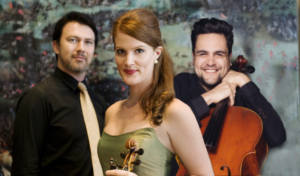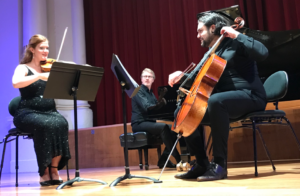Independent Theatre, North Sydney; Sunday 24th August 2018

Melbourne cellist Blair Harris joined violinist Emma Jardine and pianist Benjamin Kopp in a wonderful afternoon concert that traced the influences of contemporary music on classical composers – from Haydn in 1795, to Ravel in 1914, to more recent composers such as Paul Schoenfeld (1985), Fazil Say (2012) to young Australian composer Harry Sdraulig (2017).
The harmonious refrains of the motifs in each composition were reflected in the elegant synchronisation of the performers – and their accord as a trio. Moments of eye contact, easily missed by some perhaps, told of their shared passion for the music and the diligent rehearsal that is needed to achieve perfection.
Joseph Haydn’s Trio in G, Gypsy, picked up the gypsy folk music of his time in three movements that conjured the mysticism and romance of those that live a less settled life. It begins in mellow tones, then forces the instruments almost to a race, where they outpace each other “more for fun than for competition”. It certainly puts the musicians through their paces, requiring fast fingers and split-second timing to match the energy of the piece.
Ravel’s Piano Trio, written as The Great War loomed, begins quietly with the rhythmical motifs picked up and echoed, until the rolling patterns of the Pantoum, that reflect pattern of a Malaysian poem where the last two lines of each stanza roll into the next. The fourth movement starts low, with the motif moving higher and higher in scale until it leads into the final movement, that begins with trickling water droplets and ends with the crescendo of a storm.

Every part of this composition demanded faultless timing and a unity of purpose and passion that shone in both the music and the faces of each of the trio.
The second part of the program took the trio to Europe in 2012 and Fazil Say’s musical interpretation of Felix Baumgartner’s jump from a helium balloon 39kms above the earth. The music contemplating the earth from his capsule, then drifting and spinning through the stratosphere and into a dance of joy as he lands safely. All the risks and the exhilaration are iterated in music that trips through the fingers of the three performers as they recapture Say’s interpretation of the feat.
In Harry Sdraulig’s Joybox, composed for Musica Viva, elements of jazz are cycled through a central concept. In Paul Schoenfeld’s Café Music, which is in Kopp’s words, “a wild, free ride” where Schoenfeld “pays homage to all things American”. Suggestions of jazz, soul, and musical theatre come together in a classical pastiche that is obviously as much fun to play as it is for the audience to listen to – and to watch.
The Independent Theatre brings the audience into the close proximity for which chamber music is written … and these three musicians are as thrilling to watch as the music that is their vocation.